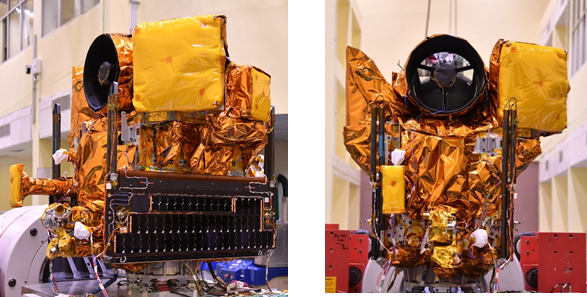SOURCE: AFI


The Indian Space Research Organisation (ISRO) is gearing up for the launch of its latest Earth Observation Satellite, EOS-08, aboard the Small Satellite Launch Vehicle (SSLV)-D3. This mission, which signifies a substantial leap in satellite technology, has several key objectives: the design and development of a microsatellite, the creation of payload instruments compatible with the microsatellite bus, and the incorporation of new technologies essential for future operational satellites.
EOS-08 is constructed on the Microsat/IMS-1 bus and carries three sophisticated payloads:
Electro Optical Infrared Payload (EOIR): This payload is capable of capturing images in the Mid-Wave IR (MIR) and Long-Wave IR (LWIR) bands, both during day and night. Its applications include satellite-based surveillance, disaster monitoring, environmental monitoring, fire detection, volcanic activity observation, and industrial and power plant disaster monitoring.
Global Navigation Satellite System-Reflectometry Payload (GNSS-R): This payload demonstrates the use of GNSS-R-based remote sensing for applications such as ocean surface wind analysis, soil moisture assessment, cryosphere studies over the Himalayan region, flood detection, and inland waterbody detection.
SiC UV Dosimeter: This instrument monitors UV irradiance at the viewport of the Crew Module in the Gaganyaan Mission and serves as a high-dose alarm sensor for gamma radiation.
The EOS-08 is designed to operate in a Circular Low Earth Orbit (LEO) at an altitude of 475 km with an inclination of 37.4°, and it has a mission life of one year. The satellite has a mass of approximately 175.5 kg and generates about 420 W of power. It interfaces seamlessly with the SSLV-D3/IBL-358 launch vehicle.
EOS-08 marks significant advancements in satellite mainframe systems, particularly with the introduction of the Integrated Avionics system, known as the Communication, Baseband, Storage, and Positioning (CBSP) Package. This system integrates multiple functions into a single, efficient unit, featuring cold redundant systems using commercial off-the-shelf (COTS) components and evaluation boards, supporting up to 400 Gb of data storage.
Additional technological innovations include:
Pyrolytic Graphite Sheet Diffuser Plate: Known for its high thermal conductivity (350 W/mK), it reduces mass and is utilized in various satellite functions.
Structural Panel Embedded with PCB: Enhances the integration of electronic components.
Embedded Battery: Improves power management and efficiency.
Micro-DGA (Dual Gimbal Antenna) and M-PAA (Phased Array Antenna): Enhances communication capabilities.
Flexible Solar Panel: Incorporates a foldable solar panel substrate, GFRP tube, and CFRP honeycomb rigid end panel, providing improved power generation and structural integrity.
The satellite employs a miniaturized design in its Antenna Pointing Mechanisms, capable of achieving a rotational speed of 6 degrees per second and maintaining a pointing accuracy of ±1 degree. The miniaturized phased array antenna further enhances communication capabilities.
The flexible solar panel design offers significant improvements in power generation and structural integrity. The foldable solar panel substrate, GFRP tube, and CFRP honeycomb rigid end panel contribute to this advancement.
EOS-08 employs advanced materials for thermal management, including AFE BGA, Kintex FPGA, Germanium Black Kapton, and STAMET (Si-Al Alloy) Black Kapton, which effectively manage the thermal properties of COTS components. A new method of integrating housekeeping panels using a hinge-based fixture significantly reduces the duration of the Assembly, Integration, and Testing (AIT) phase.
The EOS-08 mission incorporates additional novel schemes, such as X-band data transmission using pulse shaping and Frequency Compensated Modulation (FCM). The satellite’s battery management system employs SSTCR-based charging and bus regulation, sequentially including or excluding strings at a frequency of 6 Hz. The TM-TC system supports dual modes, including CDMA and Direct PSK, with miniaturized microstrip filters tailored for data and TM-TC applications.
The mission also highlights ISRO’s indigenization efforts, evident in its solar cell fabrication processes and the use of a Nano-Star Sensor for Microsat Applications. The inertial system benefits from reaction wheel isolators that attenuate vibrations, and a single antenna interface is utilized for TTC and SPS applications.
EOS-08 stands as a testament to ISRO’s commitment to advancing satellite technology. From its sophisticated payloads to its innovative mainframe systems, the satellite is poised to provide valuable data for a range of applications, including disaster monitoring, environmental observation, and remote sensing. As ISRO continues to push the boundaries of space technology, missions like EOS-08 pave the way for future advancements and operational capabilities.